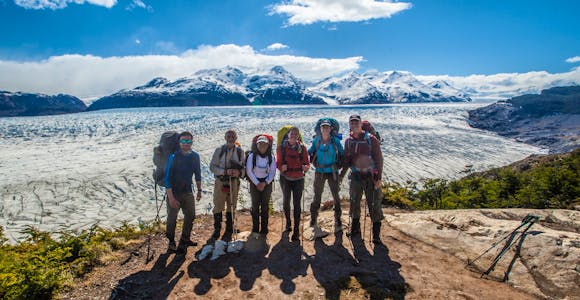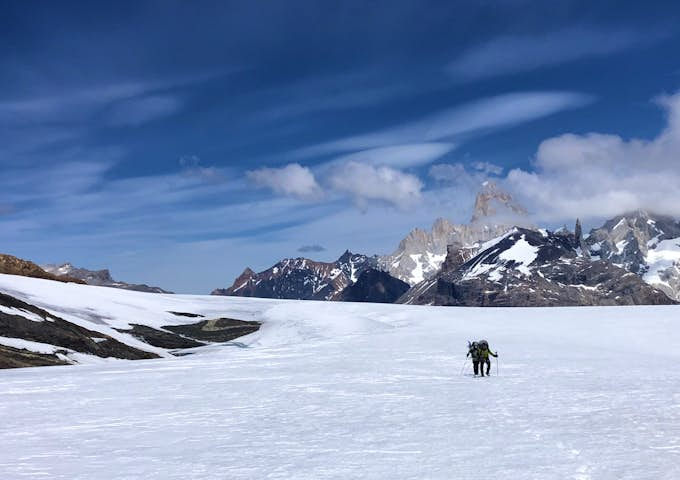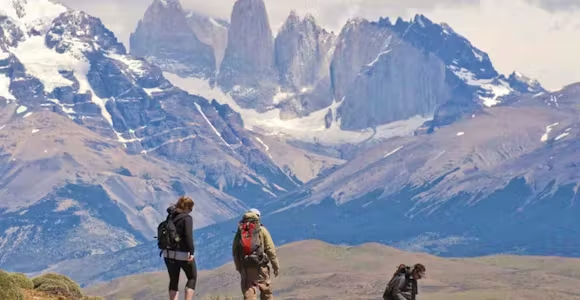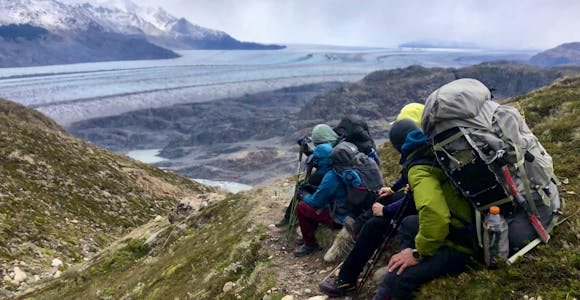The O Circuit Trek

The O Circuit is a great trek for experienced hikers, spending over a week to explore both Torres del Paine’s most popular sights and its quieter trails.
Discover MoreDeep roots in Patagonia: We are ex-guides, tour leaders, outdoor enthusiasts, & adventurers.
We’ve got our feet on the ground: Impartial advice, a bespoke service, and at no extra cost.
For the ends of the Earth: Sustainability is more than our carbon footprint (but we’re reducing that too).
Deep roots in Patagonia: We are ex-guides, tour leaders, outdoor enthusiasts, & adventurers.
We’ve got our feet on the ground: Impartial advice, a bespoke service, and at no extra cost.
For the ends of the Earth: Sustainability is more than our carbon footprint (but we’re reducing that too).

The South Patagonian Ice Field is one of the most extreme and beautiful environments on the planet, and challenging yourself on a traverse across its frozen expanses is one of the biggest adventures you can take in Patagonia. From the steep ascent up the wind-scoured Marconi Pass to ice camping at Circo de Los Altares, this is an adventure like no other.



South Patagonian Ice Field Expedition



85km | 53 miles
6 days
Elevation gain: +7,812ft/2,381m
Elevation loss: -8,438ft/2,572m
Distance 12 miles (19 km)
Elevation 18000 ft (550m) ascent, 0 ft (0m) descent
Duration 9 hours (Challenging)
The first day of the South Patagonian Ice Field expedition starts with an easy hike through light forest and along a glacial valley, before a strenuous climb towards the first mountain pass of the trek.
The trailhead for the expedition is at a bridge across the Eléctrico River, about nine miles (15 km) northwest of El Chaltén. You start the hike in an easy manner, with the trail following the river and cutting in and out of the lenga forest that covers the valley. Lunch is usually taken at the Piedra del Fraile campsite where there is a small refuge hut tucked into the trees.
From here the terrain changes quite rapidly as you turn towards the Pollone River. You cross a boulder field before fording the river (which is both fast and very cold), and crossing areas of exposed rock and slab.
After crossing the river for a second time by Tyrolean traverse on a zipline over a thin canyon, you enter the Valle de los Catorce. This is dominated by more boulders and slab, alongside fast streams and waterfalls tumbling down from the mountains.
The valley here is very exposed to the wind, but offers tremendous views of the Marconi Glacier. After a stiff climb, you’ll reach a spot to make your first wild camp of the expedition and prepare for an early assault on the Marconi Pass the next morning.
Distance 6 miles (10 km)
Elevation 1640 ft (500m) ascent, 0 ft (0m) descent
Duration 6 hours (Challenging)
The first day of the South Patagonian Ice Field expedition is one of the most challenging of the trek and should not be underestimated. It tackles an extremely steep mountain pass climb, but one that brings the ultimate reward: your first footsteps on the ice field itself.
The morning ascent of the Paso Marconi (Marconi) pass is tough and exposed, with near vertical patches that require both confidence in rocky terrain and extreme concentration. The wind, snow and ice can make the conditions particularly punishing. Whenever you stop to take a break however, you are gifted with increasingly fantastic views.
On completing the forest section of the pass, you’ll put on harnesses, crampons and be roped together for the final ascent to the ice. This stretch is also very physically demanding. On attaining the ice field itself, all your labours are rewarded. The great plateau of the ice field unfurls itself before you in all its overwhelming glory.
Against a blanket of endless white you’ll see the whole of the FitzRoy Massif rising up from the ice, and the peak of Gorra Blanca. Still roped up and wearing your crampons, you now hike on the ice field itself, crossing its cracks and crevasses.
You will be walking along the undelineated border between Argentina and Chile towards a small hut erected by the Chilean National Park service at the base of Gorra Blanca, where you’ll stay for the night. It’s rustic but will feel like five star accommodation after the day’s labours.
While you don't need any technical skills to tackle the Marconi Pass, those with any rock climbing skills will definitely find the ascent more straightforward – especially when carrying a heavy rucksack.
Distance 7 miles (11 km)
Elevation 0 ft (0m) ascent, 820 ft (250m) descent
Duration 6 hours (High)
The third day of the South Patagonian Ice Field expedition is relatively short to allow some recovery time from the exertions of the Marconi Pass, while starting to explore the majesty of the ice field.
The hiking today involves little change in elevation, although flat on the ice field still means negotiating rough ice and crevasses while being roped up and wearing crampons.
The goal of the day is to reach Circo de Los Altares, one of the remotest and most beautiful campsites in Patagonia. You’ll camp on the ice in a natural amphitheatre with western faces of FitzRoy and Cerro Torre on one side and the vast expanse of the ice field on the other.
In good weather, walking on the ice field can be a very meditative experience, losing yourself among your thoughts and the great white expanse of the landscape. You are hiking on the world’s third largest ice cap and will feel as far from the day to day of modern life as it is possible to feel on the planet.
By the time you reach your campsite and put up your tents, you’ll have a newfound appreciation of Patagonia’s beauty – as well as being a master of roping up and the other technical aspects of traversing a giant glacier.
Hikers on the Paso del Viento
Climbing to Paso del Viento
Distance 10 miles (16 km)
Elevation 0 ft (0m) ascent, 5000 ft (150m) descent
Duration 8 hours (Challenging)
The fourth day of the South Patagonian Ice Field expedition has the last full day hiking on the ice field proper, before crossing a pass to emerge into moraine and alpine grassland.
This is a long day on the trail. The first part of the day hopefully begins with a spectacular sunrise over Cerro Torre, before you rope together to tackle the final stage of the ice field traverse.
You’ll be used to crossing crevasses by now, but as you begin to approach the Paso del Viento (Windy Pass), the wind can often blow strongly against you, continually testing your energy levels. Close to the pass, the ice begins to be replaced by rough moraine, which is rocky and often unstable underfoot.
As you reach the summit, you’ll stop to catch your breath and enjoy the high mountain vistas in every direction, as well as a sweeping insight into how the epic glacial forces have shaped the landscape.
From the pass, it’s relatively straightforward descent to the Paso del Viento campsite next to Lago Ferrari, a small lagoon. The setting is scrubby grassland braided with streams, that looks positively lush after the frozen austerity of the ice field.
The site is still very exposed however: circular windbreaks have been built here from rocks to provide an extra level of shelter from the winds: you'll want to take advantage of these if you can.
Distance 11 miles (18 km)
Elevation 1760 ft (535m) ascent, 3890 ft (1190m) descent
Duration 9 hours (High)
The sixth day of the South Patagonian Ice Field expedition has the last major climb of the trek, walking above the Viedma Glacier to cross a final mountain pass before descending to a lake whose shores are littered with icebergs.
Setting out for the day, the trail soon leaves behind the green grass of the campsite as it winds its way up toward the Paso Huemul (Huemul Pass). You are accompanied the entire way by views of the blue craggy tongue of the Viedma Glacier as it snakes past distant peaks.
The pass is not steep but it can be extremely windy and tiring, so the approach is a slow and steady one. At the top you’re greeted with stunning views down to where the glacier calves into Lake Viedma.
The lake is in constant view as you now make a very steep and often challenging descent. The terrain is very rocky, and although there are often low trees for impromptu windbreaks, many people find the sharp inclines here quite tough going.
Finally, the gradient loosens up to offer a steady downhill walk to the shores of the lake at Bahía de los Témpanos (the Bay of Icebergs). It’s possible to camp right on the shore, but depending on the weather your guide may suggest a more sheltered campsite in the trees a short walk from the beach.
Distance 10 miles (16 km)
Elevation 1370 ft (420m) ascent, 1360 ft (420m) descent
Duration 6 hours (Low)
The sixth day of the South Patagonian Ice Field expedition is its most relaxed, with just an easy walk through gorgeous scenery that allows you to wind down after the intensity of the ice cap.
After breakfasting by the icebergs on the beach, you leave the camp on a trail that gently rises above and away from the lake on rolling pampa. The terrain is a mix of grassland and low scrub. There are a number of small streams to ford, as well as patches of marshy ground, so stick to the trail for the easiest passage.
The trail then softly descends to meet the lower Túnel River. This is too deep and fast to wade across, so instead you’ll cross by Tyrolean traverse, clipping yourself to a zipline and pulling yourself over by hand.
Reaching the far bank of the river marks the end of the trek. From here, a transfer will take you the final five miles (8 km) back to El Chaltén.
As a measure of the true expeditionary nature of this trek, ensure that you build two contingency days into your plans. The extremely changeable nature of the weather on the ice field may require the group to spend an extra night at a campsite waiting for better conditions to complete the trek.
Conversely, if there is fine weather on the trek, the reserve days offer the potential for further exploration on the ice field. This may include the opportunity to summit Gorra Blanca or hike around the jagged Circo de Los Altares.
The exact programme will be determined by your guides and the weather forecast during the trek and cannot be planned in advance, making a flexible attitude essential for all trekkers joining the expedition.

South Patagonian Ice Field Expedition guide trips scored 4/5 from 13 reviews
The highlight for me was the Patagonia southern ice field. I have just never seen anything even remotely comparable to this in my life, which made it truly breathtaking and unique.
Travelled: December 2017
Katherine - USA
Review:
You will need to a carry a laden 75 litre rucksack with all your clothing, camping gear, food and technical equipment. For sleeping, bring a sleeping bag rated for 10F (-12C) and an inflatable sleeping mat. A full geodesic 4-season tent is essential. We would recommend a multifuel or gas canister stove and fuel for both can be found in El Chalten.
Dress for four seasons in a single (cold) day, with a windproof and waterproof jacket and warm layers including a thermal underwear, fleece midlayer, downjacket, a warm hat, neck gaiter (buff) and mountaineering gloves. Crampon compatible boots that support your ankles are a must, plus sandals for river crossings. Trekking poles are essential.
There are several items of technical equipment that are compulsory for the trek: you will need crampons, snowshoes, rope, harness, an ice axe and helmet for crossing the ice field. For the Tyrolean traverse, you will also need, two carabiners and a safety line; all groups must also carry a thin cord of at least 20 m length. A map and camping stove are also essential.
On our guided expeditions then you will be supplied with all the technical and camping gear and will need to bring your own clothing, poles, sleeping bag and mat.
You can find outdoor gear shops in El Chaltén selling and hiring new and pre-owned kit.

The South Patagonian Ice Field expedition is not a beginner's trek. It is an extremely challenging route that requires a level of fitness that should not be underestimated. Those signing up should have remote trekking experience and ideally some technical mountaineering/climbing experience.
The terrain on the trek is tough and dynamic and must all be navigated while carrying a rucksack weighing 40-46 pounds (18-21 kg). You must be prepared to take this load over rough moraine, sheer rocky ascents, crevasse-ridden glaciers and on ziplines across fast-flowing rivers: all in often extreme weather conditions.
As well as training for the expedition with long hiking days and a heavy pack, you must mentally prepare for some extreme and unpredictable weather: wind that can knock you sideways and storms that may have you cowering in your tent. You must approach this trek with a very flexible mindset. The itinerary evolves as the trek progresses and conditions change, so the ice field is not a place for trekkers who need their itineraries to be set in stone and you must be adapatable.

The days are long and hard on the South Patagonian Ice Field Expedition, but it’s the perfect challenge for experienced trekkers looking to push themselves against some of the most dramatic landscapes and weather in the world.
The majority of the South Patagonian Ice Field expedition is an unsupported wild camping trek. You will need to carry the food you’ll eat as well as camping equipment.
On the ice field itself, there is basic refuge hut at Gorra Blanca, and the campsite at Paso del Viento have simple shelters for refuge and cooking in. There are no toilet facilities on this trek; when wild camping you must use designated toilet areas and carry a small shovel to bury excrement.
A camping stove is a mandatory piece of kit; campfires are not permitted. If you are trekking with a guide, they will cook for you, otherwise you must be entirely self-supported. Water is taken from glacial-fed streams – some of the purest water on the planet.
The entire expedition operates on the ‘Leave no trace’ principle, so you must carry all waste out with you from the trek.

This is a very intense and challenging expedition. As well as a very high level of fitness, you will need experience in similar remote treks, carrying a heavy backpack for multiple days. While rock climbing or mountaineering experience is not technically required, it is recommended if possible.
You can do the trek from October to March. While the ice cap is permanent, spring and autumn can still bring snow at the lower altitudes. The 18 hour long summer days can tend to being the clearest skies, but the winds can be strongest at this time of year.
Whenever you travel, be prepared for extreme weather conditions.
To trek the ice field, trekkers need to carry crampons, snowshoes, rope, an ice axes, harness and helmet. Carabineers and sling are are also required for the Tyrolean traverse.
On an organised tour, all technical equipment is provided, but you will need to bring your own sleeping bag and sleeping mat.
This is a mostly wild camping trip, so you will be constantly up close to nature, pitching your tent in some spectacular landscapes. There are no toilets or showers; you must use designated toilet areas near each camp. One night is spent in a refuge hut on the ice field, which has very basic facilities.
Trekkers need to be entirely self-sufficient when it comes to food. A camp stove is a mandatory piece of kit; campfires are forbidden. Pure drinking water is taken direct from glacial streams. On an organised trek, all food is provided.
Pure drinking water is taken direct from glacial streams.
Yes. Camping spots are limited during this expedition so you might need to share a tent with another trekker, or possibly a guide.
Porters can be arranged when you're booking the expedition. A porter can carry up to 27 lbs (12kg), so you will still have to carry a rucksack – they are just there to help lighten your load.
The expedition involves camping at the base of Gorra Blanca. Depending on the experience of the group, the weather conditions and the judgement of the guide, it may be possible to attempt the peak or part of it, but if your interest is specifically centred on climbing Gorra Blanca, please speak to us about arranging a special itinerary.
All guides carry a satellite phone on this expedition. In case of a critical situation, our emergency protocol will be activated to trigger the rescue teams for evacuation.

The O Circuit is a great trek for experienced hikers, spending over a week to explore both Torres del Paine’s most popular sights and its quieter trails.
Discover More
The W Trek is Torres del Paine most famous hiking route, which can be walked in a variety of ways, from a multi-day trek to a series of day hikes.
Discover More
Perfect for tried and tested trekkers, these iconic routes in Torres del Paine, El Chaltén and Tierra del Fuego are expertly guided for a fully immersive experience.
Discover MoreWe are guides, guardians, and travellers with over 400,000 hours of lived experience in Patagonia.
From a world of options, we’ll help you discover your perfect trip.
We care deeply about protecting Patagonia, that’s why 1% of our revenue goes to conservation.
Our dedicated support throughout will make sure you have the experience of a lifetime.
We'll spend some time listening to your aspirations, then discuss the kind of experience that might suit you.
Next we'll discuss the options, shortlist the best trips for you and present you our impartial recommendations.
We'll place a 24 hour hold on your preferred option - without obligation - whilst we talk through the details.
Whatever your budget, group size, length of stay, preferred activity or appetite for adventure, we can help.
1-888-970-4571This website uses cookies to ensure you get the best experience on our website. Privacy policy